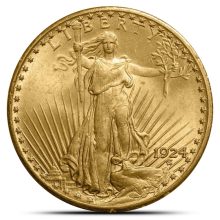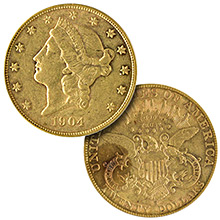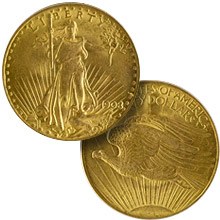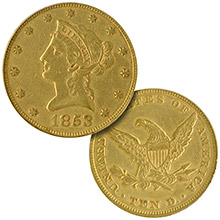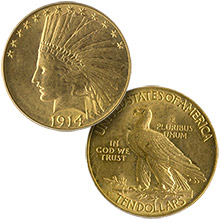Pre-1933 US Mint Gold
Pre-1933 US Mint Gold Coins at BGASC
On April 5th, 1933, U.S. President Franklin D. Roosevelt signed Executive Order 6102 “forbidding the hoarding of gold coin, gold bullion, and gold certificates within the continental United States.” Owning and possessing monetary gold became a crime as the order required monetary gold to be returned to a Federal Reserve Bank branch for fiat paper money. The order was issued a month after Presidential Proclamation 2039 that forbids the hoarding of gold or silver coin or bullion under penalty of fine and/or imprisonment up to ten years! After that, the Gold Reserve Act of 1939 codified Roosevelt’s order and imposed new civil penalties; many individuals were prosecuted for possessing gold under these laws. As a result, vast quantities of gold coins were turned in, taken out of circulation, and melted. These moves during the early days of the Great Depression ended the long history of producing gold coins for circulation use in the United States, and simultaneously depleted the available number of these coins that would survive into the 21st century.
Pre-33 US Gold Coins – Gold Content
There are many ways to look at the history of Pre-33 US Gold Coins. One of those options is to view the evolution of these coins based on the purity of the gold in the coins. When the $10 Eagle and $5 Half Eagle were introduced in 1795, the US Mint used 22-karat gold based on the English crown gold alloy. The US Mint issued these two denominations, as well as the $2.50 Quarter Eagle introduced in 1796, with 91.67% gold content. The following changes to the gold content of the coins were later made:
- 1834 – the gold content is lowered to 89.92% purity
- 1837 – the gold content was raised to 90% purity
During this period, the other metals in the alloy varied. Initially, the US Mint permitted a combination of between 0% and 4.167% silver with either a matching 4.167% copper or a full 8.33% copper. By 1840, not only had the 90% gold purity level been solidified, but so too had the inclusion of other metals. Silver was phased out entirely in favor of striking coins with 90% gold and 10% copper. This alloy would continue through 1933.
Pre-33 US Gold Coins – Denominations
When it comes to Pre-33 US Gold Coins, the dominant series that was used the most frequently was known as the US Eagle. The standard US Eagle was the $10 (USD) denomination, while the Half Eagle ($5), Quarter Eagle ($2.50), and Double Eagle were also issued up until 1933. These four coins were the backbone of Pre-33 circulation gold in the United States, but were not the only denominations. The US Mint also briefly offered $1 (USD) and $3 (USD) gold coins in the era between the California Gold Rush and the end of Reconstruction in the American South after the Civil War.
Pre-33 US Gold Coins – Designs
Of the coins mentioned above, the four denominations of the US Eagle are the most common and most popular among modern investors and collectors. Additionally, these four denominations offer the most variety in design as each had a longer history than the $1 and $3 US Gold Coins. Below, you’ll find a breakdown of the design history for each US Eagle denomination:
- Turban Head – the original Lady Liberty design on American currency, the Turban Head was a right-profile bust of Liberty that featured from 1795 to 1804 with a small heraldic eagle on the reverse until 1797 and a larger heraldic eagle from 1797 to 1804.
- Liberty Head – the longest-used design in the series was the Liberty Head, or Coronet, design. It featured on all denominations from 1838 until 1907, with issues through 1866 lacking the US national motto and all issues from 1866 onward bearing the national motto.
- Indian Head – the final design had variations across the denominations, with a Saint-Gaudens Indian Head design on the $10 Eagle and Bela Lyon Pratt’s Indian Head design on the $5 Half Eagle and $2.50 Quarter Eagle until 1933/1929. The Half Eagle and Quarter Eagle were last struck in 1929.
- Saint-Gaudens Liberty – the final design on the $20 Double Eagle was Saint-Gaudens’ famous Lady Liberty design that now graces the obverse of the American Gold Eagle bullion coin.
Certified Pre-33 US Gold Coins
One of the most common options you’ll find when shopping Pre-33 Gold Coins today is a certified coin. While many of the surviving Pre-33 Gold specimens are in conditions that showcase a good deal of wear and tear from handling or circulation use, there are those items that have Mint State or other certification levels from the Professional Coin Grading Service or Numismatic Guaranty Corporation. In many cases, these coins were either stored in bank vaults for decades or secretly held by individuals after the end of gold coining in 1933, resulting in coins with less visible wear, tear, and damage.
Buying Pre-1933 US Mint Gold Coins from BGASC
We’re happy to assist you with any questions about Pre-33 US Gold Coins. You can simply call BGASC customer service at 888-992-4272. Alternatively, we are available through our web chat and email address features.





